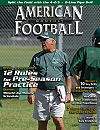Article CategoriesAFM Magazine
|
Subscribers Ask: With Patrick Ross Head Coach • Lindenwood Universityby: AFM Editorial Staff© More from this issue Over the last few years, Patrick Ross has gained a reputation for both turning programs around and having prolific offenses. In his second season at Ottawa University in 2003, Ross’ team improved from 5-5 to 9-2, winning the KCAC title and advancing to the national playoffs. He was named national NAIA Coach of the Year the following season, his first at Lindenwood, leading the Lions to an 11-0 regular season record. That year Lindenwood tied for the same number of wins the team earned in the previous four years combined. Last fall, the Lions averaged over 50 points per game. The year before, Ross led Lindenwood to the best season in the program’s history. Playing in the NAIA Championship Game that season, the Lions fell short of the title, losing to Sioux Falls, 25-22. The 2009 team scored the most poi....The full article can only be seen by subscribers.
|
|
|||||||
| HOME |
MAGAZINE |
SUBSCRIBE | ONLINE COLUMNISTS | COACHING VIDEOS |
Copyright 2026, AmericanFootballMonthly.com
All Rights Reserved





